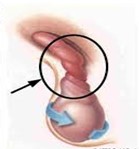Scrotal Exploration for Testicular Torsion
Surgical salvage of a twisted spermatic cord, with orchiopexy and spermatic cord block

Who is susceptible?
- Newborn babies: Often missed diagnosis.
- 12–16-year-old boys as their testes increase in size with puberty.
Why is it done?
- To reverse a twisted spermatic cord compromising blood supply to the testis.
- This should be done within 4-6 hours of the first presenting symptoms.
- A failed manual detorting of the testis.
How is it done?
 This procedure is performed under general anesthetic.
This procedure is performed under general anesthetic.- A single incision is made on the midline raphe of the scrotum.
- The affected testis and vas deference is then extracted through this incision.
- The testis is then un-twisted.
- The testis is then covered with a warm wet swab, encouraging blood supply in the testis by means of Vaso-dilatation.
- Once the dusky blue grey colour is replaced by a pink colour, the testis is pexed to the dartos muscle.
- If the testis is black on opening the scrotum and no change occurs with the revival process, the testis is removed.
- The contra-lateral testis is pexed to the dartos muscle.
- A dressing is then applied, which should be removed after 72 hours.
- No strenuous movements are permitted for at least 14 days.
What to expect after the procedure?
- Any anesthetic has its risks, and the anesthetist will explain all such risks.
- A hematoma (blood collection under the skin) may form and needs to be reviewed by Dr Schoeman as soon as possible. Bruising is normal.
- An infection of the wound can occur and requires immediate attention.
- Owing to the nature of the surgery and the soft skin of the scrotum, bruising may appear to be much worse than it actually is and is no cause for alarm.
- DANGER SIGNS: A scrotum that swells immediately to size of a football, fever, puss. Contact Dr Schoeman or the hospital immediately as this may occur in up to 5% of all cases.
What next?
- The dressing should be kept dry for the initial 72 hours after surgery and then soaked in a bath until the dressing comes off with ease.
- The dressing may sometimes adhere to the wound causing slight bleeding on removal.
- Do not tug at the sutures!
- PLEASE CONTACT THE HOSPITAL DIRECT WITH ANY POST OPERATIVE CONCERNS AND RETURN TO THE HOSPITAL IMMEDIATELY SHOULD THERE BE ANY SIGNS OF SEPSIS.
Download Information Sheet

Leave a Reply
Want to join the discussion?Feel free to contribute!